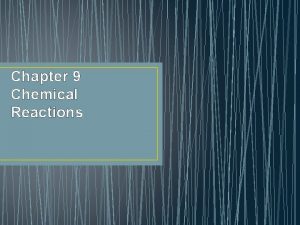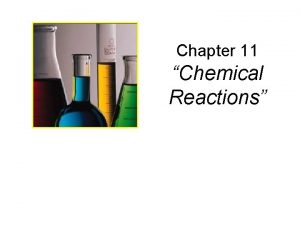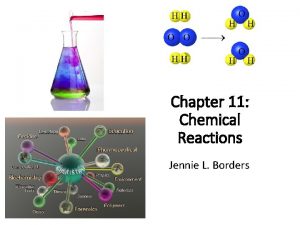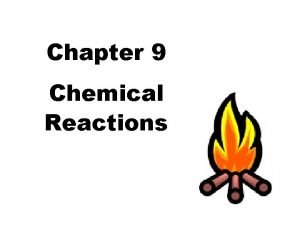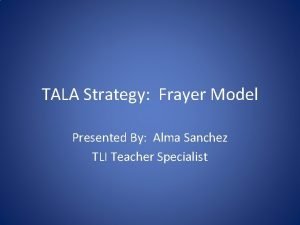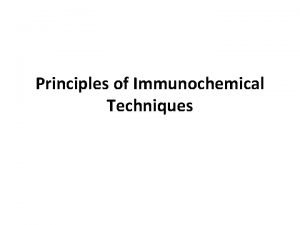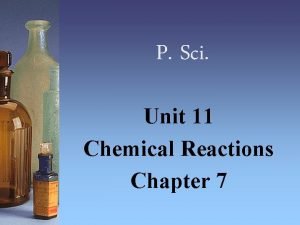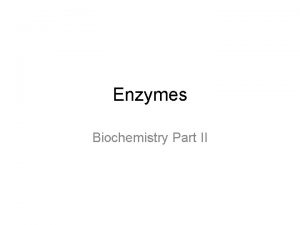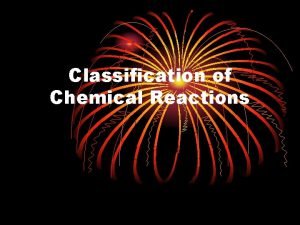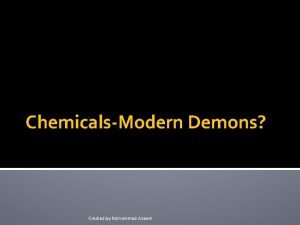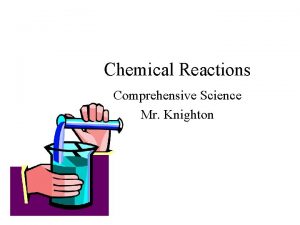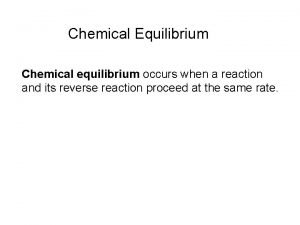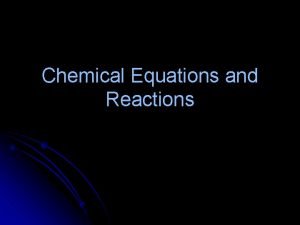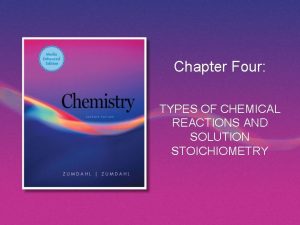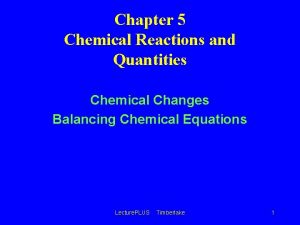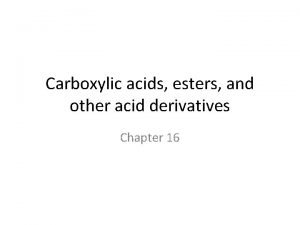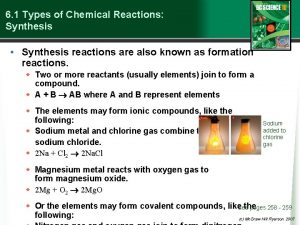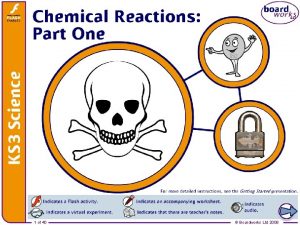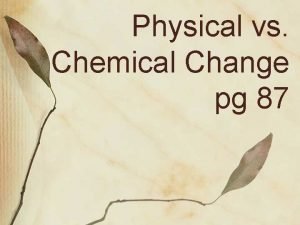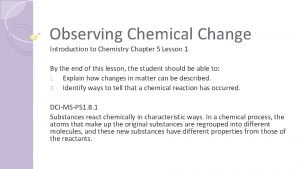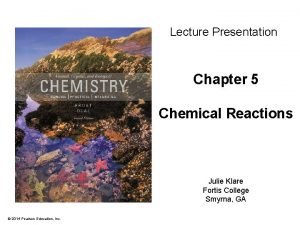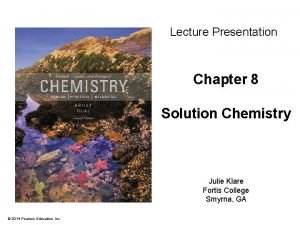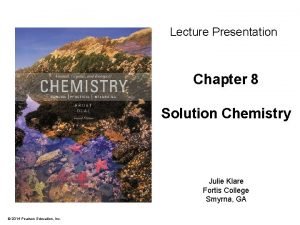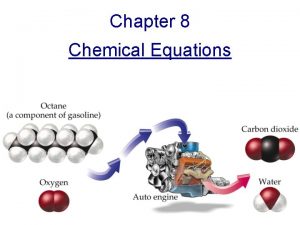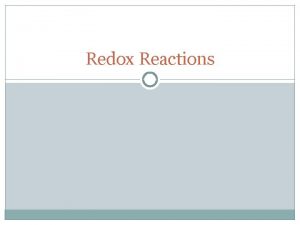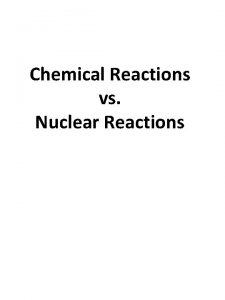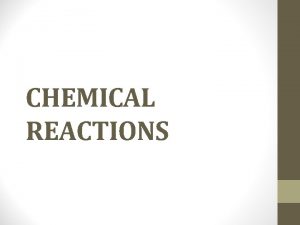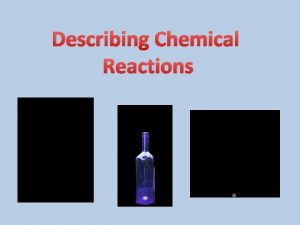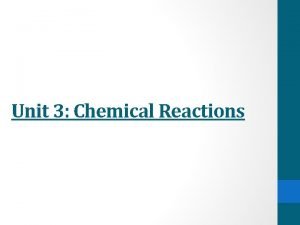Lecture Presentation Chapter 5 Chemical Reactions Julie Klare


























































- Slides: 58

Lecture Presentation Chapter 5 Chemical Reactions Julie Klare Fortis College Smyrna, GA © 2014 Pearson Education, Inc.

Outline • 5. 1 Thermodynamics • 5. 2 Chemical Reactions: Kinetics • 5. 3 Overview of Chemical Reactions • 5. 4 Oxidation and Reduction • 5. 5 Organic Reactions: Condensation and Hydrolysis • 5. 6 Organic Addition Reactions: Hydrogenation and Hydration © 2014 Pearson Education, Inc.

5. 1 Thermodynamics • Some chemical reactions produce energy, while others require energy in the form of heat. • A reaction that gives off heat is an exothermic reaction (exo, out; thermic, heat; heat flows out). 4 Fe(s) + 3 O 2(g) → 2 Fe 2 O 3(s) + Heat • Reactions requiring heat energy are endothermic reactions (endo, in; thermic, heat; heat flows in). Heat + NH 4 NO 3(s) → NH 4 NO 3(aq) © 2014 Pearson Education, Inc.

5. 1 Thermodynamics • The energy necessary to align the reactant molecules and to cause them to collide with enough energy to form products is the activation energy. • If the energy in the reactant molecules is less than the activation energy, the molecules will bounce off each other without forming products. © 2014 Pearson Education, Inc.

5. 1 Thermodynamics • A reaction energy diagram is a way to visually examine the energy changes that occur in a chemical reaction. • Energy appears on the y-axis, and the reaction progress from reactants to products appears on the x-axis. • Notice that each reaction has an activation energy hill to climb before proceeding to products. © 2014 Pearson Education, Inc.

5. 1 Thermodynamics • The free energy (G), also called Gibbs free energy, is the amount of energy present in molecules available to do work. • The free energy change, DG, is the energy difference between the free energy present in the product and reactant molecules. • When molecules react, some chemical bonds are broken and others are formed. • Breaking a bond is a process that requires input of energy, and making a bond releases energy, so free energy is exchanged during a chemical reaction. • Not all chemical bonds have the same strength. © 2014 Pearson Education, Inc.

5. 1 Thermodynamics • For an exothermic reaction, the free energy of the reactants is greater than the free energy of the products and DG is negative. • Reactions with a negative DG value do not require energy input and occur spontaneously. • Spontaneous processes will continue to occur once started and do not require energy from the surroundings. • DG can predict spontaneity, but does not imply the rate of a chemical reaction. © 2014 Pearson Education, Inc.

5. 1 Thermodynamics • In an endothermic reaction, the free energy of the products is higher than that of the reactants. • Energy is absorbed and the value of DG is positive. • Reactions with a positive DG value require energy input from their surroundings and are nonspontaneous. • Nonspontaneous processes do not occur naturally and require energy input. © 2014 Pearson Education, Inc.

5. 1 Thermodynamics Calorimetry: An Application of Thermodynamics • A calorimeter measures the amount of energy in food by burning the food in the presence of oxygen. • The food is placed inside a closed container surrounded by water and burned. • The change in the temperature of the water is directly related to the amount of energy released. • The energy is commonly reported in units of nutritional Calories or kilojoules. • Remember that a nutritional Calorie (Cal) is an energy unit equal to 1000 calories (cal). © 2014 Pearson Education, Inc.

5. 1 Thermodynamics © 2014 Pearson Education, Inc.

5. 1 Thermodynamics Energy Content in Food • Whether outside the body or inside the body, when oxygen reacts with molecules producing carbon dioxide, water, and energy, the process is called combustion. • Even though our cells combust the molecules differently, the calorimeter provides an accurate caloric value because the end products of the two reactions are the same. • The food we eat contains different amounts of energy. © 2014 Pearson Education, Inc.

5. 1 Thermodynamics © 2014 Pearson Education, Inc.

5. 1 Thermodynamics © 2014 Pearson Education, Inc.

5. 1 Thermodynamics Low-Calorie Foods • Most of the Calories in a soft drink come from sugar. • Non-sugar sweeteners undergo very few chemical reactions in the body so do not produce much energy. • Fats produce the highest amount of energy per gram when they undergo chemical reactions in the body (9 Cal/g). • Manufacturers of baked goods have introduced fat substitutes to produce low-fat alternatives. • Substances such as dextrins, celluloses, and gums are carbohydrate-based molecules that produce less energy (4 Cal/g) when eaten. © 2014 Pearson Education, Inc.

5. 2 Chemical Reactions: Kinetics • Chemical reactions with a lower activation energy proceed more quickly (have a faster rate) than reactions with a higher activation energy. • We can measure the rate of reaction by determining the amount of product formed (or reactant used up) in a certain period of time. • For a chemical reaction to occur, the molecules of the reactant(s) must collide with each other with enough energy and the proper orientation. • Any factor that affects either of these affects the rate of the reaction. © 2014 Pearson Education, Inc.

5. 2 Chemical Reactions: Kinetics Temperature • Increasing temperature increases the kinetic energy (motion) of the reacting molecules. • As a result, they collide with each other more often, causing more reactions to occur. • In biological systems, if temperatures cannot be maintained, hypo- or hyperthermia results in part due to changing reaction rates. • Under normal conditions, the temperature remains constant in a biological system, and temperature does not affect reaction rate. © 2014 Pearson Education, Inc.

5. 2 Chemical Reactions: Kinetics Amount of Reactant • The rate of chemical reactions increases with the amount of reactants. • More reactant available allows the molecules to collide with each other more often, causing more reactions to occur. • As reactants are consumed and form products, chemical reactions slow down due to a decrease in the amount of reactants. © 2014 Pearson Education, Inc.

5. 2 Chemical Reactions: Kinetics Catalyst • A catalyst speeds up a reaction by lowering the activation energy. • A catalyst participates in a chemical reaction but remains unchanged and can be used again. • A catalyst is neither a product nor a reactant. • Acids, bases, and metal ions often act as catalysts. • Many catalysts immobilize reactants near each other, increasing the likelihood of collision and therefore the rate of reaction. © 2014 Pearson Education, Inc.

5. 2 Chemical Reactions: Kinetics Catalyst • When hydrogen peroxide is put on a cut, oxygen gas is produced by the decomposition of hydrogen peroxide by an enzyme, catalase, found in the blood. 2 H 2 O 2(l) catalase → 2 H 2 O(l) + O 2(g) • Catalysts are written above or below the arrow in the reaction equation. • In the absence of the catalyst, the hydrogen peroxide reaction occurs very slowly. © 2014 Pearson Education, Inc.

5. 2 Chemical Reactions: Kinetics Enzymes Are Biological Catalysts • The body maintains a constant temperature. • The amount of reactant present in cells is constant. • Most biochemical reactions use enzymes to increase reaction rates. • Most enzymes are proteins. • Enzymes can enhance the rate of a chemical reaction by a factor of more than ten million (1 ✕ 107). • Enzymes speed up reactions by immobilizing the reactants at a active site, which orients them correctly for the reaction to occur. • Enzymes are highly specific: when they are defective, it often results in a disease state in the organism. © 2014 Pearson Education, Inc.

5. 2 Chemical Reactions: Kinetics © 2014 Pearson Education, Inc.

5. 3 Overview of Chemical Reactions • Synthesis reactions occur when smaller molecules or atoms combine to create larger molecules. Synthesis reactions often require energy, as more bonds are broken than formed when smaller molecules join to build larger ones. These reactions have only one product. • Decomposition reactions break apart larger molecules into smaller molecules. Decomposition reactions often give off energy since more chemical bonds are formed in the smaller molecules than broken in the larger molecule during these reactions. These reactions have only one reactant. • Exchange reactions, sometimes called displacement reactions, involve both synthesis and decomposition. © 2014 Pearson Education, Inc.

5. 3 Overview of Chemical Reactions © 2014 Pearson Education, Inc.

5. 3 Overview of Chemical Reactions • Reversible reactions can form products in either direction. • If a chemical bond can be formed, with enough input of energy it can also be broken. • Reversible chemical reactions are indicated with a pair of arrows between the reactants and products pointing in opposite directions. A+B ⇌ © 2014 Pearson Education, Inc. AB

5. 3 Overview of Chemical Reactions A+B ⇌ AB • The forward reaction occurs when A and B form AB. • When a sufficient amount of AB builds up, the reverse reaction occurs and A and B re-form. • At the point when both the forward and the reverse reaction are occurring at the same rate, the reaction is said to be in a state of chemical equilibrium. • This does not mean that there are equal amounts of reactants and products; it means that the reaction reaches a point where the amount of products remains constant. © 2014 Pearson Education, Inc.

5. 3 Overview of Chemical Reactions • Reactions that are highly exothermic are for practical purposes irreversible reactions. • For example, rejoining combusted molecules once they are dissipated into the atmosphere requires too much energy. • When we break down food, these chemical reactions are never reversed to re-form the actual food. • The energy produced is used to form other molecules and maintain bodily functions. © 2014 Pearson Education, Inc.

5. 3 Overview of Chemical Reactions Combustion • Combustion involves a carbon-containing molecule reacting with oxygen to produce carbon dioxide and water. • Combustion reactions tend to be highly exothermic and are considered irreversible. • Combustion reactions are a type of decomposition reaction and are also oxidation-reduction reactions. • Combustion reactions use oxygen and produce energy, whether it dissipates as heat or performs work. • They are an important part of understanding fuels. • The products are always carbon dioxide and water, making these reactions a useful place to start an exploration of organic chemical reactions. © 2014 Pearson Education, Inc.

5. 3 Overview of Chemical Reactions Alkanes • Alkanes are excellent fuel sources because they give off a lot of energy when burned. • Internal combustion engines emit partially reacted hydrocarbons in their exhaust. • Other hydrocarbons are not completely oxidized, and carbon soot results. • The term clean-burning refers to the efficiency of the combustion. The cleaner it burns, the more complete the combustion. © 2014 Pearson Education, Inc.

5. 3 Overview of Chemical Reactions Distinguishing Chemical Reactions • For many organic reactions, the interesting part is the mechanism of the reaction. • When writing an organic chemical equation, the structure of organic molecules is written out. • Small molecules that participate in the reaction are shown above the reaction arrow, and reaction conditions are shown below the arrow. © 2014 Pearson Education, Inc.

5. 3 Overview of Chemical Reactions Distinguishing Chemical Reactions • Biochemical reactions are written like organic reactions: the reactant, product, and reaction conditions are shown. • Sometimes biochemical reactions are coupled: energy is transferred from one reaction to fuel the other. • The two reactions are often written together with the energy transfer reaction written at the arrow. © 2014 Pearson Education, Inc.

5. 3 Overview of Chemical Reactions © 2014 Pearson Education, Inc.

5. 4 Oxidation and Reduction Inorganic Oxidation and Reduction • Atoms that lose electrons during a chemical reaction are said to undergo oxidation. • Atoms that gain electrons during a chemical reaction are said to undergo reduction. • The oxidized species is also known as the reducing agent, and the reduced species is the oxidizing agent. © 2014 Pearson Education, Inc.

5. 4 Oxidation and Reduction Inorganic Oxidation and Reduction • Metal atoms generally lose electrons to form cations becoming oxidized. • Nonmetals gain electrons to form anions becoming reduced. • Oxidation and reduction reactions are always coupled. • A mnemonic device for remembering what is happening to the electrons in a redox reaction is to remember the letters in the words “OIL RIG. ” © 2014 Pearson Education, Inc.

5. 4 Oxidation and Reduction Biochemical Oxidation and Reduction • In biological systems, cells oxidize and reduce metals. • A protein called cytochrome c plays an important role in ATP production. • This protein contains an Fe 2+ that undergoes oxidation to Fe 3+ followed by reduction back to Fe 2+. The iron is held in place on a small organic molecule called a heme. © 2014 Pearson Education, Inc.

5. 4 Oxidation and Reduction Organic Oxidation and Reduction • An organic molecule is oxidized if it gains oxygen or loses hydrogen and is reduced if it gains hydrogen or loses oxygen. © 2014 Pearson Education, Inc.

5. 4 Oxidation and Reduction Oxidation in Cells • We fuel our bodies with nutrients that are broken down through oxidation. • In the body, the process of combustion occurs through a chemical pathway, transferring energy as it goes. • The series of reactions through which glucose is combusted is cellular respiration. • Ethanol is oxidized to the aldehyde ethanal, also called acetaldehyde. • In the case of ethanol oxidation, the reduced molecule is nicotinamide adenine dinucleotide, abbreviated NAD+. • NAD+, and flavin adenine dinucleotide (FAD) are two important molecules used in metabolic oxidation–reduction reactions. © 2014 Pearson Education, Inc.

5. 5 Organic Reactions: Condensation and Hydrolysis • In a condensation reaction, water is produced as two organic molecules are joined. • Condensation reactions occur among functional groups that contain an —H and —OH group that can be removed to form water. • In an hydrolysis reaction (hydro- means “water”, lysis means “break”), water is consumed as a reactant and the reactant molecule is split into two smaller molecules. © 2014 Pearson Education, Inc.

5. 5 Organic Reactions: Condensation and Hydrolysis • Condensation and hydrolysis reactions are common biochemical reactions. • The energy molecule ATP is hydrolyzed to ADP through a hydrolysis. © 2014 Pearson Education, Inc.

5. 5 Organic Reactions: Condensation and Hydrolysis • Carboxylation reactions involve the addition of a carboxyl, or carboxylic acid, group. • As carbon dioxide moves through the cell, it is added to and removed from small molecules by two enzymes called carboxylase and decarboxylase, respectively. © 2014 Pearson Education, Inc.

5. 6 Organic Addition Reactions • In an addition reaction to an alkene, an atom or group of atoms is added to a double bond in an organic molecule. • The second bond in a double bond is broken and two single bonds are formed. • Atoms are added to the carbons that were in the double bond. © 2014 Pearson Education, Inc.

5. 6 Organic Addition Reactions Hydrogenation • During a hydrogenation reaction, two hydrogen atoms are added, converting an alkene double bond to an alkane single bond. • A catalyst such as platinum (Pt), nickel (Ni), or palladium (Pd) is used. © 2014 Pearson Education, Inc.

5. 6 Organic Addition Reactions Hydrogenation • A complete hydrogenation changes an unsaturated fatty acid into a saturated fatty acid. • Hydrogenation of fatty acids often does not affect every alkene bond: some will re-form as trans bonds. • Some studies have shown that trans fats have deleterious health effects. © 2014 Pearson Education, Inc.

5. 6 Organic Addition Reactions Hydration • Hydration is the addition of water to the double bond in an alkene. • The water gets added as —H and —OH. This reaction often requires acid as a catalyst. © 2014 Pearson Education, Inc.

5. 6 Organic Addition Reactions Hydration • If the alkene double bond is asymmetric, the —H will bond to the carbon with more hydrogen atoms. • The —OH will bond to the carbon with more carbon groups attached. • A Russian chemist named Vladimir Markovnikov was the first chemist to notice this. This observation is called Markovnikov’s rule. © 2014 Pearson Education, Inc.

Summary of Reactions © 2014 Pearson Education, Inc.

Summary of Reactions Combustion Cx. Hy + O 2 → CO 2 + H 2 O Condensation/Hydrolysis: Reactions are the reverse of each other. © 2014 Pearson Education, Inc.

Summary of Reactions Addition Reactions to Alkenes • Hydrogenation • Hydration © 2014 Pearson Education, Inc.

Chapter Five Summary • 5. 1 Chemical Reactions: Energy and Heat – Reactions that give off heat are exothermic, and those that absorb heat are endothermic. – For a chemical reaction to occur, the reactants must collide with each other with enough energy to react. – This initial energy required for a reaction to occur is called the activation energy. – The thermodynamics of a chemical reaction can be represented on a reaction energy diagram showing the energy of the reactants, products, the activation energy, and the free energy change, DG. © 2014 Pearson Education, Inc.

Chapter Five Summary • 5. 1 Chemical Reactions: Energy and Heat – If DG is negative, the reaction is spontaneous. – If DG is positive, the reaction is nonspontaneous. – We can measure the heat given off in a chemical reaction by calorimetry. – This method is used to determine the joules in a chemical reaction and calories (Cal) in food. © 2014 Pearson Education, Inc.

Chapter Five Summary • 5. 2 Chemical Reactions: Reaction Rates – Chemical reactions occur when reactants collide. – Several factors control the rate of a chemical reaction. Increasing the rate of collision can be accomplished by increasing the amount of reactants or increasing the temperature (kinetic energy) of the reactants. – Catalysts participate in a chemical reaction but remain unchanged at its completion. Catalysts increase the rate by lowering the activation energy. – Enzymes are biological catalysts that lower activation energy by providing an active site, where the reactants are close and in the correct orientation to react instead of being positioned randomly in a reaction mixture. © 2014 Pearson Education, Inc.

Chapter Five Summary • 5. 3 Overview of Chemical Reactions – There are three basic types of chemical reaction: synthesis, decomposition, and exchange. – Depending upon the amount of energy released during a chemical reaction, these reactions can be further classified as either reversible or irreversible. – Reversible reactions can reach a point called chemical equilibrium where the rates of the forward and reverse reactions are constant and no net products are formed. © 2014 Pearson Education, Inc.

Chapter Five Summary • 5. 3 Overview of Chemical Reactions – Organic hydrocarbons can undergo combustion (reaction with oxygen, O 2) to form carbon dioxide (CO 2) and water (H 2 O). – General reactions are written to determine amounts, so balancing them is important. – Organic reactions are usually written to show functional groups change during the reaction, so their structures are written out. – Biochemical reactions show organic structures and also can show energy coupling and enzymes used to catalyze the reactions. © 2014 Pearson Education, Inc.

Chapter Five Summary • 5. 4 Oxidation and Reduction – Oxidation and reduction (redox) reactions always occur simultaneously. – Oxidation always involves a loss of electrons and may involve the addition of oxygen or removal of hydrogen. – Reduction always involves a gain of electrons and may involve the addition of hydrogen or a removal of oxygen. – If one substance in a reaction is oxidized, another substance in the reaction is reduced. – If metals are involved, it is easier to determine which substance is oxidized or reduced by determining the charge on the metal. – In organic reactions, look for the movement of oxygen and hydrogen. – Combustion (reaction with oxygen) is an example of a redox reaction. © 2014 Pearson Education, Inc.

Chapter Five Summary • 5. 5 Organic Reactions: Condensation and Hydrolysis – Organic condensation and hydrolysis reactions occur in opposite directions. – A condensation reaction joins molecules and produces water. – Hydrolysis reactions break molecules and water is a reactant. – Carboxylations and phosphorylations are examples of biological condensation reactions. – Dephosphorylation is an example of a biological hydrolysis reaction. © 2014 Pearson Education, Inc.

Chapter Five Summary • 5. 6 Organic Addition Reactions: Hydrogenation and Hydration – The addition reactions hydrogenation and hydration are also very common in biological molecules. – In addition reactions, two atoms or groups of atoms are added to the alkene double bond, forming a carbon-carbon single bond. – In a complete hydrogenation, one hydrogen atom is added to each carbon of the double bond. – In hydration, an —H and an —OH are added to the carbons. – In a hydration of an alkene with different groups attached to the alkene, the hydrogen will bond to the carbon in the double bond with more hydrogens bonded directly to the alkene. This is Markovnikov’s rule. © 2014 Pearson Education, Inc.

Chapter Five Study Guide • 5. 1 Thermodynamics – Draw reaction energy diagrams for exothermic and endothermic reactions. – Predict spontaneity based on DG value. – Describe how a calorimeter works. – Calculate the energy content in a food. • 5. 2 Chemical Reactions: Reaction Rates – Predict relative activation energies and speed of reactions using a reaction energy diagram. – Determine the effect that temperature, amount of reactants, and catalyst have on the rate of a reaction. – Describe how an enzyme catalyzes a biochemical reaction. © 2014 Pearson Education, Inc.

Chapter Five Study Guide (continued) • 5. 3 Overview of Chemical Reactions – Classify reactions as synthesis, decomposition, or exchange reactions. – Distinguish reversible and irreversible reactions. – Predict the products and balance the chemical equation for a hydrocarbon undergoing combustion. – Contrast a general chemical equation and an organic chemical equation. • 5. 4 Oxidation and Reduction – Identify the substance oxidized and the substance reduced in an inorganic oxidation-reduction reaction. – Identify the substance oxidized and the substance reduced in an organic oxidation-reduction reaction. © 2014 Pearson Education, Inc.

Chapter Five Study Guide (continued) • 5. 5 Organic Reactions: Condensation and Hydrolysis – Predict the products of an organic condensation reaction. – Predict the products of an organic hydrolysis reaction. • 5. 6 Organic Addition Reactions: Hydrogenation and Hydration – Predict the products of a hydrogenation reaction, an addition reaction of an alkene. – Predict the products of a hydration reaction, an addition reaction of an alkene. – Relate the properties of the organic reactions condensation, hydrolysis, oxidation, and reduction to biochemical reactions. © 2014 Pearson Education, Inc.
 Section 2 reinforcement classifying chemical reactions
Section 2 reinforcement classifying chemical reactions Section 2 classifying chemical reactions worksheet answers
Section 2 classifying chemical reactions worksheet answers Klare texte schreiben
Klare texte schreiben Chapter 18 chemical reactions balancing chemical equations
Chapter 18 chemical reactions balancing chemical equations Chemical reactions section 3 reactions in aqueous solutions
Chemical reactions section 3 reactions in aqueous solutions Section 1 chemical changes
Section 1 chemical changes Chapter 10 chemical reactions answer key
Chapter 10 chemical reactions answer key Chapter 9 chemical reactions
Chapter 9 chemical reactions Chapter 9 chemical reactions
Chapter 9 chemical reactions Chapter 8 review chemical equations and reactions
Chapter 8 review chemical equations and reactions Chemical reactions chapter 9 study guide
Chemical reactions chapter 9 study guide Chapter 8 section 1 chemical equations and reactions
Chapter 8 section 1 chemical equations and reactions Chemical equations and reactions chapter 8
Chemical equations and reactions chapter 8 Chapter 11 chemical reactions answer key
Chapter 11 chemical reactions answer key Chapter 11 chemical reactions practice problems
Chapter 11 chemical reactions practice problems Chapter 19 chemical reactions answer key
Chapter 19 chemical reactions answer key 5 types of chemical reactions
5 types of chemical reactions What are active metals
What are active metals An example of redox reaction
An example of redox reaction Unit 5 chemical reactions answers
Unit 5 chemical reactions answers 01:640:244 lecture notes - lecture 15: plat, idah, farad
01:640:244 lecture notes - lecture 15: plat, idah, farad Chapter 7 review chemical formulas and chemical compounds
Chapter 7 review chemical formulas and chemical compounds Love chemical formula
Love chemical formula Stoichiometry island diagram
Stoichiometry island diagram Unit 5 chemical reactions
Unit 5 chemical reactions Redox rules
Redox rules Types of reaction
Types of reaction 4 types of chemical reactions
4 types of chemical reactions Chemical reaction types
Chemical reaction types Predicting products of chemical reactions
Predicting products of chemical reactions 4 types of chemical reactions
4 types of chemical reactions Non examples of chemical reactions
Non examples of chemical reactions The calculations of quantities in chemical reactions
The calculations of quantities in chemical reactions Immunoelectrophoresis
Immunoelectrophoresis Predicting products of chemical reactions
Predicting products of chemical reactions Predicting products synthesis
Predicting products synthesis Combination reaction equation
Combination reaction equation Unit 11 chemical reactions
Unit 11 chemical reactions Toxic reactions chemical equations worksheet answers
Toxic reactions chemical equations worksheet answers Four types of chemical reactions
Four types of chemical reactions Biology-roots.com
Biology-roots.com Describing chemical reactions
Describing chemical reactions Chemical reactions classification
Chemical reactions classification Chemical reactions in everyday life
Chemical reactions in everyday life 5 general types of chemical reactions
5 general types of chemical reactions Chemical reactions reactants and products
Chemical reactions reactants and products 5 general types of chemical reactions
5 general types of chemical reactions Solubility rules
Solubility rules Equilibrium occurs when
Equilibrium occurs when What are the 4 types of chemical reactions
What are the 4 types of chemical reactions Four types of chemical reactions
Four types of chemical reactions 5 chemical reactions
5 chemical reactions Section 2-4 chemical reactions and enzymes
Section 2-4 chemical reactions and enzymes Isomers of carboxylic acid
Isomers of carboxylic acid Summary of chemical reactions
Summary of chemical reactions Chemical reaction of bread
Chemical reaction of bread Types of chemical reactions and solution stoichiometry
Types of chemical reactions and solution stoichiometry Solvent in chemical reactions
Solvent in chemical reactions Fatoumata dembele chef
Fatoumata dembele chef










